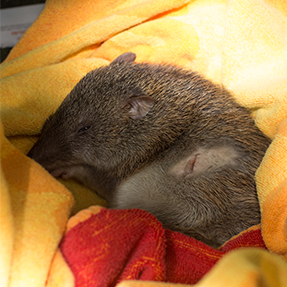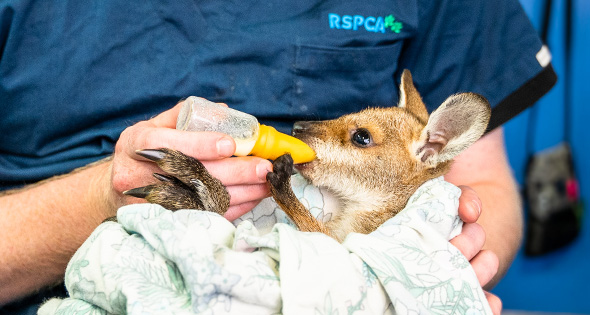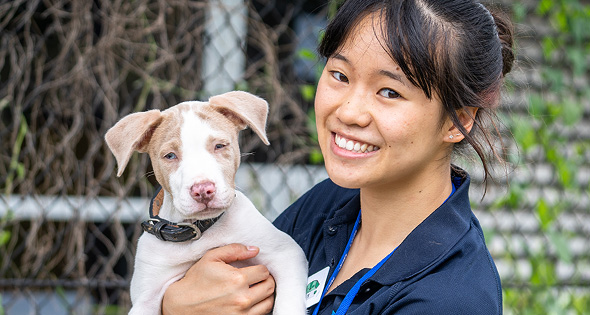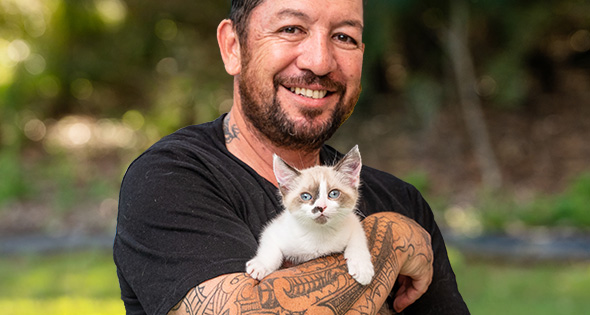BACKGROUND
Fraser Island is a declared National Park and Recreation Area, and a World Heritage Area. This classification provides protection for the Fraser Island Dingo (FID) as a native species (Nature Conservation Act 1992, s17 and 62) although dingoes are a declared pest in Queensland (Rural Lands Protection Act 1985, s70(4)). Actions that interfere with the FID, including feeding, are legislated offences punishable by substantial fines (Nature Conservation Regulation 1994 and Recreation Areas Management By-laws 1991). The feeding of dingoes encourages them to seek out humans, scavenge for food, and lose the ability to hunt. This in turn increases the risk of negative dingo/human interactions which could result in offending dingoes being shot.
The Fraser Island Dingo Management Strategy (FIDMS) addresses the Government’s concerns regarding public safety, and was put in place primarily to protect and manage the dingo and provide a viable alternative to a complete cull. The Queensland Government Department of Environment and Resource Management (DEHP) through its Queensland Parks and Wildlife Division (QPWS)), is responsible for the implementation and ongoing management of the FIDMS. The FIDMS imposes relatively rigid reporting conditions on QPWS with respect to alleged dingo attacks and the destruction of dingoes involved.
Complaints to RSPCA
The number of complaints made to RSPCA concerning FID welfare has steadily increased in recent years and the RSPCA continues to liaise with DEHP about the FID. The complaints received by RSPCA fall loosely within several broad categories.
Neglect:
The Animal Care and Protection Act 2001 (ACPA) does not provide for prosecution of DEHP or QPWS in relation to allegations of neglect of the FID or any other wildlife. Section 17 of the ACPA provides an offence of breach of duty of care in relation to an animal. However, one essential element needed to establish this offence is the identification of a “person in charge” of the animal. Section 12 of the Act defines ‘person in charge’ as being an owner or having custody of the animal. The FID is a wild animal which is not owned by, or in the custody of, any person. Therefore there can be no breach of duty of care. This is the case for all wildlife. There is one exception to this and that is when a wild animal is under the care of someone. For example, when a dingo is trapped or restrained in some way as part of the FIDMS, or during rehabilitation of an injured wild animal. In these circumstances the person in charge of the animal has a duty of care for that animal.
Cruelty:
Section 18 of the ACPA provides the offence of cruelty to an animal. The definition of cruelty for the purposes of prosecution under the ACPA is clearly defined in s18. It is necessary, when the act involves injuring the animal, to prove the act is unjustifiable, unnecessary or unreasonable. A Government Department and its employees implementing an authorised management plan would certainly be exempt from this provision so long as they were acting within the scope of the plan.
If anyone, including employees from QPWS, were found to be performing cruel acts, acts not authorised by law or the management plan, they would be investigated and, providing sufficient evidence was obtained to support a charge, they would proceddd through the prosecution process[1].
Starvation:
The most common and emotive complaint is that the FID is starving to death. Several studies, including Dingo Diet and Prey Availability on Fraser Island by biologist Dafna Camila Angel-E, 2006, have not found any lack of dingo food on the island. However, it is possible that some animals are underfed. This is a difficult issue and more research is needed to clarify the status of the FID with respect to their weight, health and dietary habits. Most of the FID look lean, particularly in comparison to our domestic pets, but are they underweight or unhealthy? Research can help answer this.
Artificial feeding may not be the answer as it would most likely inflate the FID population, increase the animals’ dependence on humans and increase the likelihood of animal/human interactions. Artificial feeding stations could be one strategy used in particular circumstances and under specific conditions.
Ear Tagging:
QPWS uses ear tagging as part of the management plan. There is currently no viable alternative and tagging is essential to the success of the FIDMS. Future research may identify an alternative identification method.
There are several concerns regarding ear tagging.
- Abandonment by parents - There is anecdotal evidence that when pups are tagged under six months of age, they are abandoned by their parents and may starve to death. QPWS advise that they do not tag pups under the age of six months.
- Injury to ear – For a short period after tagging, the dingo’s ear may drop – although it almost always returns to the upright position. Sometimes head shaking causes an haematoma (large blood filled sac) on the ear.
- Infection – Infection at tagging site is a possibility, particularly if fellow dingoes chew the tag.
- Obstruction – The ear tag may prevent or hinder the dingo from hunting and displaying its natural behaviours. Also, the tag may become caught in bushes, leading to injury.
QPWS report these unfortunate sequelae are uncommon and they do not constitute a breach of the ACPA.
Grids and Fences:
The fences and grids are a part of the FIDMS and were established to negate the need for mass culling. DEHP reports that since the erection of the fences and grids the number of reported dingo attacks and consequent dingo destructions has reduced. However, the fences need constant maintenance to play their role and welfare mitigation devices (for example, tracks for other wildlife to pass through the fence safely) also need to be maintained.
Baiting:
Aversive baiting using lithium chloride was recommended in the FIDMS to discourage dingoes from frequenting camping and picnic grounds, and reinstitute wariness of people. However, apart from one early experimental program, no further aversive baiting has taken place, and QPWS confirm they have no intention of utilising aversive baiting in the future.
There have been allegations that the lethal poison 1080 is being used on Fraser Island. QPWS have assured RSPCA that this bait has never been used on Fraser Island and if it is being used, it is unauthorised and should be reported to authorities.
Soft Jaw Trapping:
When dingoes need to be caught for tagging, treatment or destruction, QPWS rangers use soft jaw trapping. These traps are essentially the same as steel jaw traps but have a padded soft section that closes on the animal’s leg seldom causing injury. According to DEHP protocols, QPWS rangers who set the trap must remain within earshot or no further than fifteen minutes travel time from the trap. RSPCA is concerned about the negative welfare impacts of these traps, supports best practice use of them, and supports research into alternatives.
Culling:
Culling is not part of the FIDMS. If dingoes on Fraser Island are killed by anyone other than QPWS rangers, and the killing is done humanely, then QPWS are empowered to take appropriate action against that person. If anyone, including QPWS rangers, kills a dingo inhumanely, then RSPCA Inspectors can conduct an investigation and prosecute the offender under the ACPA if sufficient evidence is obtained.
Dingoes are destroyed, however, if they are constantly participating in negative dingo/human interactions involving aggression. The particular animal involved must be identified and their negative behaviour recorded. There are stringent guidelines controlling the destruction of dingoes.
Hazing:
One of the most contentious FIDMS still being employed is aversive hazing. This practice involves spraying clay pellets at the ground near dingoes to deter them from certain areas. It is only effective when employed consistently at a particular area. This technique does have the potential to injure dingoes if used inappropriately, if aimed directly at the animals and if the firing occurs when the dingoes are too close.
CONCLUSION
Despite the apparent success of the FIDMS in terms of a reduction in the number of dingo attacks and destructions, QPWS is still dissatisfied that potentially dangerous human/dingo interactions occur. They continue to explore various management strategies aimed at reducing adverse interactions to negligible levels. QPWS believe that most dingoes involved in attacks or intimidation of people are juveniles. If these dingoes can be prevented from attacking humans until they are two years old, their chances of being destroyed are reduced.
RSPCA has an important role to play with respect to FID in terms of monitoring welfare, investigating complaints and liaising with all key stakeholders. However, FID is a human safety and conservation issue and as such is managed by the Queensland Government. There is a need for continued close dialogue between all stakeholders and in particular, good communication with the general public. RSPCA plays an important role in being a point of contact for the public and providing well-balanced and factual information.
[1] To date there have been no substantiated complaints regarding cruelty to dingoes by members of the public or government employees.








